Quality of Groundwater Used for Domestic Drinking-Water Supply in the Coachella Valley, 2020
Links
- Document: Report (6 MB pdf) , HTML , XML
- Data Release: USGS data release - Groundwater-quality data in the Coachella Valley Domestic Supply Aquifer Study Unit, 2020: Results from the California GAMA Priority Basin Project (ver. 2.0, May 2022)
- Download citation as: RIS | Dublin Core
Abstract
Groundwater is the primary source of drinking water in the Coachella Valley in the desert region of southern California. Although most people in Coachella Valley are served by public drinking-water systems, about 20,000 people rely on private domestic or small-system wells (referred to herein as domestic wells). Recently, the U.S. Geological Survey (USGS) found that 39 percent of the groundwater resources used by domestic wells in Coachella Valley contained arsenic, fluoride, or both constituents at concentrations greater than the maximum contaminant levels established for public drinking-water systems. Uranium, chromium, nitrate, and perchlorate were detected at moderate concentrations below maximum contaminant levels. Elevated (above background) perchlorate concentrations in some areas indicate that domestic wells may receive recharge from Colorado River water used for irrigation or aquifer replenishment. Moderate total dissolved solids (TDS) concentrations throughout the study area and the co-occurrence of high concentrations of TDS and perchlorate indicates that Colorado River water is a source of recharge in the southeastern Indio groundwater subbasin. Four volatile organic compounds were detected at low concentrations, and pesticides and per- and polyfluoroalkyl substances were not detected.
The Coachella Valley Study Unit
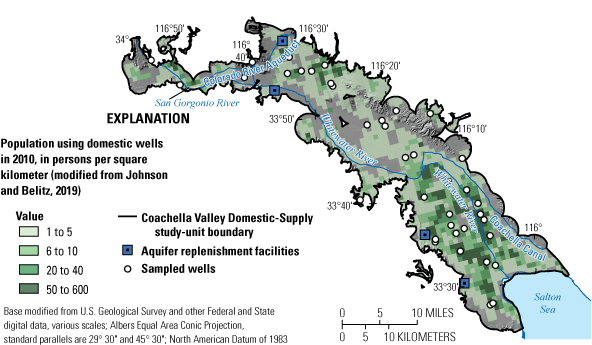
The Coachella Valley Domestic-Supply study unit encompasses most of the Coachella Valley groundwater basin (California Department of Water Resources, 2020). About 20,000 people rely on private domestic wells located outside of the larger urban areas of the study unit that are served by public drinking-water systems (Johnson and Belitz, 2019). Wells from State small water systems were included in this study because they generally tap similar aquifer depths as private domestic wells rather than deeper aquifers used for public supply. The lack of comprehensive water-quality data for domestic wells has been identified as a critical information gap by the California State Water Resources Control Board (California State Water Resources Control Board, 2020).
Coachella Valley is structurally divided into four groundwater subbasins. Groundwater flows from recharge areas along valley margins toward the Whitewater River in the center of the valley and south toward the Salton Sea (California Department of Water Resources, 2020), with additional recharge coming from managed aquifer replenishment (MWH Constructors, 2015). Nearly one-half of the land use in the study area is natural (47 percent) with the remainder divided between urban (37 percent) and agricultural (16 percent) uses (Falcone, 2015). Previous studies of groundwater resources used for public drinking-water supply in Coachella Valley indicated moderate to high concentrations of trace elements (for example, arsenic and fluoride) but very low occurrence of organic constituents (Dawson and Belitz, 2012; Wright and others, 2015).
A total of 37 wells were sampled by the Groundwater Ambient Monitoring and Assessment Program Priority Basin Project (GAMA-PBP) during January–July 2020 to provide a statistically representative assessment of the quality of groundwater resources used for domestic drinking-water supply in Coachella Valley. The wells ranged in depth from 80 to 909 feet below land surface (median depth of 495 feet), and groundwater levels in the wells ranged from artesian to 280 feet below land surface (Soldavini and others, 2021).
Overview of Water Quality
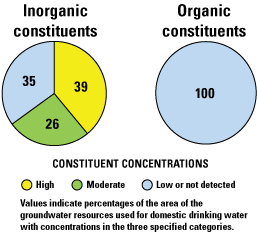
The quality of untreated groundwater used for domestic drinking-water supply in Coachella Valley was categorized using comparisons to established water-quality benchmarks used for public drinking-water supply. Groundwater-quality results are presented as spatially weighted proportions of groundwater resources used by the domestic drinking-water supply with high concentrations that exceed a benchmark (see “Methods for Evaluating Groundwater Quality” section for definitions of high, moderate, and low concentrations). Results for constituents with regulatory, health-based benchmarks (maximum contaminant levels [MCLs]) are presented separately from results for constituents with aesthetic-based (secondary maximum contaminant levels [SMCLs]) and non-regulatory, health-based benchmarks (health-based screening levels [HBSLs]; lifetime health advisory levels [HALs]; response levels [RLs]; notification levels [NLs]). Many inorganic constituents are naturally present in groundwater, and concentrations of these inorganic constituents can be affected by natural processes and human activities. In contrast, organic constituents are generally introduced to groundwater through human activities.
Results: Quality of Groundwater in the Coachella Valley
Inorganic Constituents with Maximum Contaminant Levels
Of the groundwater resources used by domestic wells in Coachella Valley, 39 percent had high concentrations of one or more inorganic constituents with an MCL benchmark, and about 26 percent of the resources had moderate concentrations. The inorganic constituents detected at high concentrations were arsenic and fluoride, and the constituents detected at moderate concentrations were arsenic, fluoride, uranium, chromium, nitrate, and perchlorate.
Trace Elements
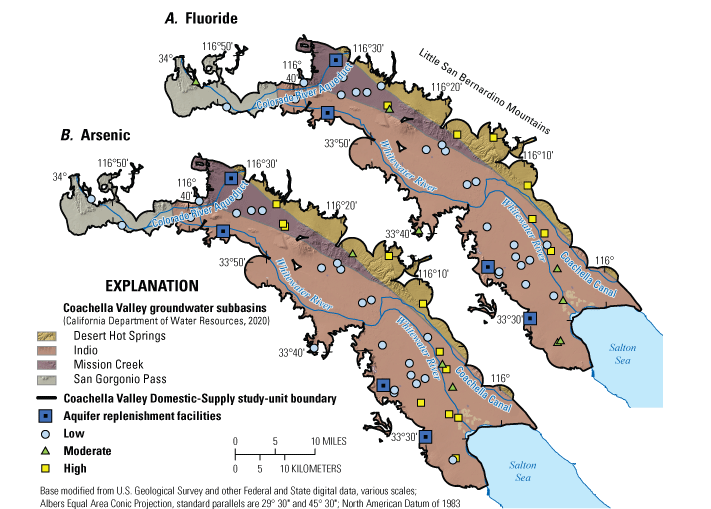
Arsenic exceeded the U.S Environmental Protection Agency maximum containment level (EPA-MCL) in 27 percent of the groundwater resources used by domestic wells. High and moderate arsenic concentrations occurred in the Coachella Valley-Desert Hot Springs (Desert Hot Springs subbasin) and Coachella Valley-Mission Creek groundwater subbasins (Mission Creek subbasin) that are adjacent to the Little San Bernardino Mountains and in the southern part of the Coachella Valley-Indio groundwater subbasin (Indio subbasin). Arsenic is naturally present in the aquifer sediments derived from adjacent mountain ranges and upwelling thermal waters that mix into the drinking-water aquifers (Welch and others, 1988; Wright and others, 2015). High pH and low dissolved oxygen conditions promote the release of arsenic from sediments, with pH being the most important in the desert region (Welch and others, 1988; Wright and others, 2015). In Coachella Valley, high and moderate concentrations of arsenic only were present in samples with pH greater than 8. Many samples with elevated arsenic concentrations also had low dissolved oxygen, which can increase the solubility of arsenic.
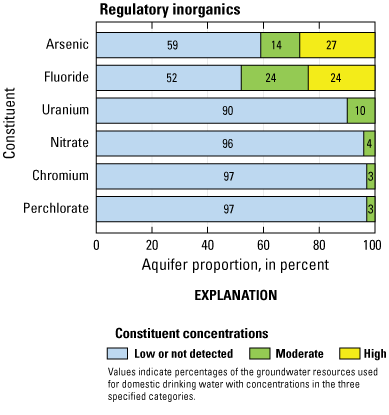
Fluoride exceeded the California maximum contaminant level (CA-MCL) in 24 percent of the groundwater resources used by domestic wells. Fluoride accumulates in groundwater in the California desert region through multiple mechanisms, including weathering of sediments derived from granitic rocks, mixing with geothermal water, and evaporative concentration (McMahon and others, 2020). High and moderate concentrations of fluoride were present in similar areas to those of arsenic but were less prevalent in the Indio subbasin. Fluoride and arsenic have similar geologic sources, but fluoride tends to be more strongly controlled by proximity to specific fluoride-bearing source rocks. The Little San Bernardino Mountains on the northeastern side of the Coachella Valley contain abundant fluoride-rich granites (Shawe and others, 1976; Morton and Miller, 2006; Harkness and Jurgens, 2022).
Nutrients
Nitrate was present at moderate concentrations in 4 percent of the groundwater resources used by domestic wells. Low concentrations of nitrate are commonly natural, but moderate or high concentrations can be derived from human sources such as fertilizers, manure, and sewage. Unlike other areas in California with agriculture, high or moderate nitrate concentrations were not common in domestic wells in the Coachella Valley. Low nitrate concentrations may be because of microbial attenuation of nitrate in anoxic (low amounts of dissolved oxygen) groundwater or the presence of a shallow confining layer in the southwestern part of the basin. This confining layer could protect the drinking-water aquifer from infiltration of water that may contain nitrate derived from agricultural land uses (Burow and others, 2010; MWH Constructors, 2015).
Special Interest Constituents
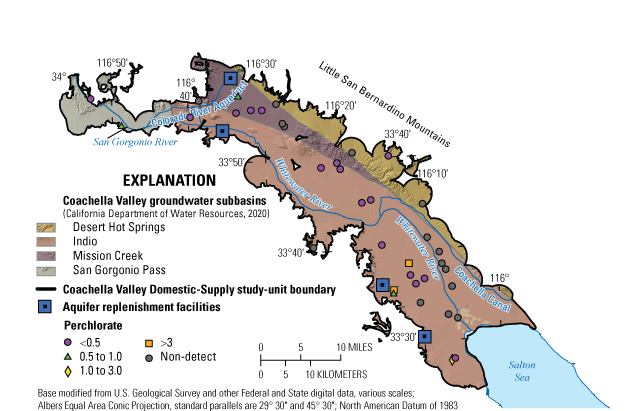
Perchlorate was only detected at low or moderate concentrations (below the CA-MCL) in the resources used for domestic wells. Perchlorate in groundwater can have natural and anthropogenic sources. Widespread detection of perchlorate at very low concentrations (0.1–0.5 parts per billion [ppb]) is consistent with natural occurrence from atmospheric deposition in arid environments like the Coachella Valley. However, the frequency of detections of perchlorate at concentrations greater than 1 ppb likely indicates contribution from anthropogenic sources (Fram and Belitz, 2011). The primary source of perchlorate to the lower Colorado River is legacy contamination from rocket fuel manufacturing facilities near Las Vegas, Nevada (U.S. Environmental Protection Agency, 2020). Colorado River water from the Colorado River Aqueduct and Coachella Canal is used extensively in the Coachella Valley for irrigation and managed aquifer replenishment, and the locations of the wells with perchlorate above natural background concentrations are common near aquifer replenishment facilities. Of the samples with elevated perchlorate, all but one had concentrations of tritium between 0.89 and 4.4 tritium units (TU) consistent with recently recharged groundwater (Soldavini and others, 2021). Future research could use perchlorate as a tracer of Colorado River water contributing recharge to domestic wells; however, perchlorate can break down in low dissolved oxygen conditions that are common in Coachella Valley groundwater, potentially limiting use of perchlorate as a tracer of recent recharge.
Organic Constituents
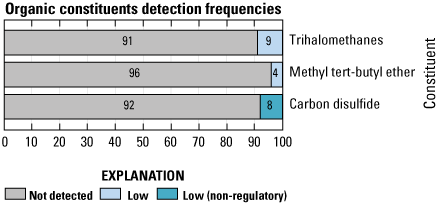
Three types of organic constituents were analyzed in samples collected for this study: (1) volatile organic compounds (VOCs), (2) pesticides, and (3) per- and polyfluoroalkyl substances (PFAS). Laboratory methods that can detect organic constituent concentrations far below the concentrations of MCLs and other benchmarks were used in the study. Detections at these low concentrations can be used to help trace the movement of water from the landscape into the aquifer system.
No pesticides or PFAS with comparison benchmarks were detected in this study. Four VOCs were detected, including two trihalomethanes (THMs), and all detections were at low concentrations. Organic constituents were not detected at concentrations greater than an MCL benchmark.
Low concentrations of THMs were detected in 9 percent of the resource used by domestic wells. The benchmark EPA-MCL is for total THMs. Trihalomethanes are formed by reaction between organic matter present in water and disinfectants, such as chlorine, that are commonly added to public drinking-water systems and domestic wells to treat for water-borne pathogens (Zogorski and others, 2006).
Microbial Indicator Constituents
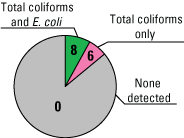
Microbial indicator constituents are used to evaluate the potential for fecal contamination of water sources. Coliform bacteria are naturally present in soils and digestive tracts of animals, whereas Escherichia coli (E. coli) is a type of coliform bacteria that is commonly associated with human and animal wastes (California State Water Resources Control Board, 2019). Total coliforms were detected in about 14 percent of the groundwater resource and E. coli in about 8 percent. The total coliform and E. coli detections are based on a single sampling of the wells in this study; the EPA benchmarks specify repeat sampling to confirm detections.
Inorganic Constituents with Secondary Maximum Contaminant Levels
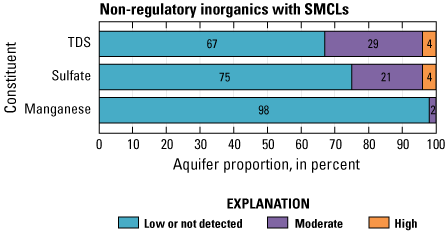
Salinity and some trace elements have SMCL benchmarks because elevated concentrations may affect the aesthetic and technical properties of the water, such as taste, odor, and pipe scaling. Of the groundwater resources used by domestic wells in Coachella Valley, 4 percent had TDS concentrations greater than the upper California secondary maximum contaminant level (CA-SMCL) of 1,000 parts per million (ppm), and another 29 percent had moderate TDS concentrations between the upper CA-SMCL and the recommended CA-SMCL (500 ppm).
In arid regions, TDS can be used as a measure of groundwater salinity. High and moderate TDS are present in the Mission Creek and Desert Hot Springs subbasins and in a few wells in the southeastern Indio subbasin. Elevated salinity in the entire Coachella Valley groundwater has been associated with extensive water-rock interactions common to aquifers with long groundwater flow paths, evaporative processes affecting recharge in the arid environment, and mixing with higher salinity geothermal water (Wright and others, 2015).
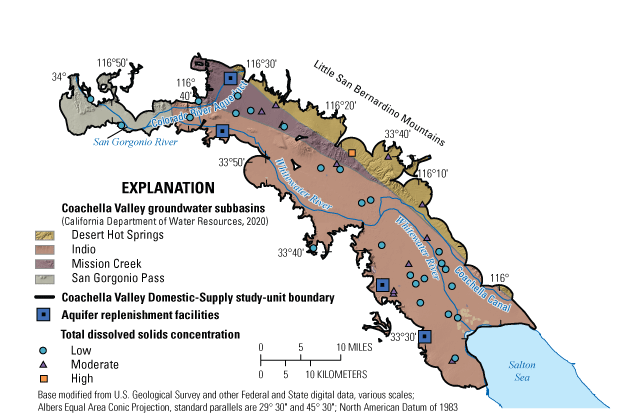
Elevated TDS concentrations in domestic groundwater resources were associated with sulfate-dominated water. High or moderate sulfate concentrations occurred in 25 percent of the groundwater resources used by domestic wells. Geothermal water tends to be enriched in sulfate and is a likely source of elevated groundwater salinity in the Mission Creek and Desert Hot Springs subbasins (California Department of Water Resources, 1964; Mayer and others, 2007). Another source of salinity to groundwater in the Indio subbasin is Colorado River water from the Colorado River Aqueduct and Coachella Canal used extensively for irrigation and for aquifer replenishment. The co-occurrence of moderate TDS and high perchlorate in the southeastern Indio subbasin supports mixing between the native groundwater and Colorado River water in this area.
Other Inorganic Constituents

Other inorganic constituents do not have MCL or SMCL benchmarks but do have other types of benchmarks (see “Methods for Evaluating Groundwater Quality” section). Molybdenum and hexavalent chromium are metallic trace elements that can have adverse health effects if consumed at high concentrations. Although there are anthropogenic sources for both these constituents, Wright and others (2015) showed that natural, geogenic sources are predominant in the Coachella Valley.
Part of the evidence for a natural, geogenic source of moderate and high concentrations of hexavalent chromium is the age of the groundwater. Tritium and carbon-14 are used as tracers of groundwater age, and most samples with moderate or high concentrations of hexavalent chromium have ages indicating that the groundwater likely recharged hundreds to thousands of years ago (Wright and others, 2015; Soldavini and others, 2021).
Methods for Evaluating Groundwater Quality
The GAMA-PBP uses comparison to regulatory and non-regulatory benchmarks developed for public drinking-water supplies to categorize the quality of groundwater in aquifers. The quality of ambient groundwater tapped by wells can differ from that of drinking water. Groundwater may be treated or blended with other water sources or may change because of interaction with plumbing systems or the atmosphere before being used as drinking water. The comparison benchmarks used for the constituents discussed in this report are listed in the table; all comparison benchmarks used in this study are listed in Soldavini and others (2021). Concentrations greater than the comparison benchmark are defined as “high;” concentrations between the benchmark and half the benchmark for inorganic constituents or one-tenth the benchmark for organic constituents are defined as “moderate.” Concentrations below moderate and non-detections are defined as “low.” Identification of constituents present at moderate concentrations can help improve understanding of processes affecting water quality in a given aquifer system.
Groundwater-quality results are presented as spatially weighted proportions of groundwater resources used by the domestic supply with high, moderate, and low concentrations of a constituent. GAMA-PBP uses a gridded sampling approach in which the study unit is divided into equal-area grid cells, and one well is sampled per cell to statistically represent the extent of the groundwater resources used by the domestic supply. In this study of Coachella Valley, some cells did not have any sampled wells and some had multiple, which necessitated the use of a spatially weighted assessment to calculate aquifer proportions. These methods are discussed in greater detail in Dawson and Belitz (2012).
Benchmark type and value for selected constituents.
The comparison benchmarks were selected in the following order of priority: (1) Regulatory benchmarks established by the U.S. Environmental Protection Agency (EPA) or the California State Water Resources Control Board Division of Drinking Water (SWRCB-DDW). (2) California secondary maximum contaminant levels (CA-SMCLs) established by the SWRCB-DDW. (3) Non-regulatory, health-based benchmarks established by the EPA or SWRCB-DDW. (4) For select constituents with no other comparison benchmarks, non-regulatory, health-based benchmarks established by the U.S. Geological Survey (USGS) were used. For more information on benchmarks, please refer to Soldavini and others (2021).
[Benchmark types: EPA-MCL, EPA maximum contaminant level; EPA-TT, EPA treatment technique; CA-MCL, California maximum contaminant level; EPA-HAL, EPA lifetime health advisory level; USGS-HBSL, USGS health-based screening level; CA-NL, California notification level; CA-RL, California response level; CA-SMCL, California secondary maximum contaminant level. For constituents with CA-MCL and EPA-MCL, the lower value was used as the comparison benchmark. For constituents with CA-RL and EPA-HAL, the lower value was used as the comparison benchmark, and the CA-NL associated with the CA-RL was used as the boundary between moderate and low concentrations. Abbreviations: ppb, parts per billion (equivalent to micrograms per liter); ppm, parts per million (equivalent to milligrams per liter)]
Priority Basin Assessments
The GAMA-PBP is a cooperative program between the California State Water Resources Control Board and the U.S. Geological Survey (USGS) to assess water quality in groundwater resources used for drinking-water supply. The initial phase of the GAMA-PBP assessed groundwater resources used for public drinking-water supply throughout California. The second phase, of which the Coachella Valley Domestic-Supply study unit is a part, is focused on characterizing the quality of drinking water used for domestic supply groundwater basins and areas outside basins throughout California.
The GAMA-PBP uses two scientific approaches for assessing groundwater quality. The first approach uses a network of wells to statistically assess the status of groundwater quality across a defined aquifer area. The second approach combines water-quality, hydrologic, geographic, and other data to help assess the factors that affect water quality. In the Coachella Valley Domestic-Supply study unit, data were collected by the USGS in 2020. The PBP includes chemical analyses not generally available as part of regulatory compliance monitoring, including measurements at concentrations lower than human-health benchmarks and measurements of constituents that can be used to trace the sources and movement of groundwater.
For more information
Technical reports and hydrologic data collected for the GAMA Program may be obtained from
GAMA Project Chief
U.S. Geological Survey, California Water Science Center
6000 J Street, Placer Hall
Sacramento, CA 95819
Telephone number: (916) 278-3000
GAMA Program Unit Chief
State Water Resources Control Board
Division of Water Quality
P.O. Box 2231, Sacramento, CA 95812
Telephone number: (916) 341-5779
WEB: https://www.waterboards.ca.gov/gama
Publishing support provided by the U.S. Geological Survey Science Publishing Network, Sacramento Publishing Service Center
References Cited
Burow, K.R., Nolan, B.T., Rupert, M.G., and Dubrovsky, N.M., 2010, Nitrate in groundwater of the United States, 1991–2003: Environmental Science & Technology, v. 44, no. 13, p. 4988–4997. [Available at https://doi.org/10.1021/es100546y.]
California Department of Water Resources, 2020, California’s groundwater—Update 2020: Sacramento, Calif., California Department of Water Resources Bulletin 118, 485 p., accessed October 12, 2021, at https://water.ca.gov/Programs/Groundwater-Management/Bulletin-118.
California State Water Resources Control Board, 2019, Groundwater information sheet— Bacteria indicators: California State Water Resources Control Board, Division of Water Quality, GAMA Program, 7 p., accessed October 5, 2021, at https://www.waterboards.ca.gov/gama/docs/coc_bacteria_indicators.pdf.
California State Water Resources Control Board, 2020, Methodology to estimate groundwater quality accessed by domestic wells in California: California State Water Resources Control Board, Division of Water Quality, Groundwater Ambient Monitoring and Assessment Unit [variously paged], accessed October 12, 2021, at https://gispublic.waterboards.ca.gov/portal/home/item.html?id=0e7fe8d490ef45fb826ab3ad86db5409.
Dawson, B.J.M., and Belitz, K., 2012, Status of groundwater quality in the California Desert Region, 2006–2008—California GAMA Priority Basin Project: U.S. Geological Survey Scientific Investigations Report 2012–5040, 110 p., accessed September 25, 2021, at https://doi.org/10.3133/sir20125040.
Falcone, J.A., 2015, U.S. conterminous wall-to-wall anthropogenic land use trends (NWALT), 1974–2012: U.S. Geological Survey Data Series 948, 33 p. plus appendixes 3–6 as separate files, accessed January 25, 2022, at https://doi.org/10.3133/ds948.
Fram, M.S., and Belitz, K., 2011, Probability of detecting perchlorate under natural conditions in deep groundwater in California and the southwestern United States: Environmental Science & Technology, v. 45, no. 4, p. 1271−1277, accessed January 25, 2022, at https://doi.org/10.1021/es103103p.
Harkness, J.S., and Jurgens, B.C., 2022, Effects of imported recharge on fluoride trends in groundwater used for public supply in California: Science of the Total Environment, v. 830, 15 p., accessed January 27, 2022, at https://doi.org/10.1016/j.scitotenv.2022.154782.
Johnson, T.D., and Belitz, K., 2019, Domestic well locations and populations served in the contiguous U.S.—Datasets for decadal years 2000 and 2010: U.S. Geological Survey data release, accessed January 25, 2022, at https://doi.org/10.5066/P9FSLU3B.
Mayer, A., May, W., Lukkarila, C., and Diehl, J., 2007, Estimation of fault-zone conductance by calibration of a regional groundwater flow model—Desert Hot Springs, California: Hydrogeology Journal, v. 15, no. 6, p. 1093–1106. [Available at https://doi.org/10.1007/s10040-007-0158-0.]
McMahon, P.B., Brown, C.J., Johnson, T.D., Belitz, K., and Lindsey, B.D., 2020, Fluoride occurrence in United States groundwater: Science of the Total Environment, v. 732, 15 p. [Available at https://doi.org/10.1016/j.scitotenv.2020.139217.]
Morton, D.M., and Miller, F.K., 2006, Geologic map of the San Bernardino and Santa Ana 30' x 60' quadrangles, California: U.S. Geological Survey Open-File Report 2006–1217, 168 p., accessed December 12, 2021, at https://doi.org/10.3133/ofr20061217.
MWH Constructors, 2015, Coachella Valley groundwater basin salt and nutrient management plan: MWH Project Number 10505158, 163 p., accessed July 15, 2022, at https://www.cvwd.org/DocumentCenter/View/2441/Coachella-Valley-Groundwater-Basin-Salt-and-Nutrient-Management-Plan-Final-PDF?bidId=.
Soldavini, A.L., Goldrath, D.A., Shelton, J.L., Johnson, T.D., and Watson, E., 2021, Groundwater-quality data in the Coachella Valley Domestic Supply Aquifer Study Unit, 2020—Results from the California GAMA Priority Basin Project: U.S. Geological Survey data release, accessed September 20, 2021, at https://doi.org/10.5066/P9UYXI95.
U.S. Environmental Protection Agency, 2020, Reductions of Perchlorate in drinking water fact sheet: U.S. Environmental Protection Agency, Office of Groundwater and Drinking Water, EPA-815-F-20-002, 13 p., available at https://www.epa.gov/sites/default/files/2020-05/documents/perchlorate_reductions_5.14.20.pdf.
Welch, A.H., Lico, M.S., and Hughes, J.L., 1988, Arsenic in ground water of the western United States: Groundwater, v. 26, no. 3, p. 333–347. [Available at https://doi.org/10.1111/j.1745-6584.1988.tb00397.x.]
Wright, M.T., Fram, M.S., and Belitz, K., 2015, Geochemical conditions and the occurrence of selected trace elements in groundwater basins used for public drinking-water supply, Desert and Basin and Range hydrogeologic provinces, 2006–11—California GAMA Priority Basin Project: U.S. Geological Survey Scientific Investigations Report 2014–5173, 48 p., accessed October 12, 2021, at https://doi.org/10.3133/sir20145173.
Zogorski, J.S., Carter, J.M., Ivahnenko, T., Lapham, W.W., Moran, M.J., Rowe, B.L., Squillace, P.J., and Toccalino, P.L., 2006, Volatile organic compounds in the Nation's ground water and drinking-water supply wells: U.S. Geological Survey Circular 1292, 101 p., accessed October 13, 2021, at https://doi.org/10.3133/cir1292.
Disclaimers
Any use of trade, firm, or product names is for descriptive purposes only and does not imply endorsement by the U.S. Government.
Although this information product, for the most part, is in the public domain, it also may contain copyrighted materials as noted in the text. Permission to reproduce copyrighted items must be secured from the copyright owner.
Suggested Citation
Soldavini, A.L., Harkness, J.S., Levy, Z.F., and Fram, M.S., 2023, Quality of groundwater used for domestic drinking-water supply in the Coachella Valley, 2020: U.S. Geological Survey Open-File Report 2022-1122, 6 p., https://doi.org/10.3133/ofr20221122.
ISSN: 2331-1258 (online)
Study Area
| Publication type | Report |
|---|---|
| Publication Subtype | USGS Numbered Series |
| Title | Quality of groundwater used for domestic drinking-water supply in the Coachella Valley, 2020 |
| Series title | Open-File Report |
| Series number | 2022-1122 |
| DOI | 10.3133/ofr20221122 |
| Publication Date | January 13, 2023 |
| Year Published | 2023 |
| Language | English |
| Publisher | U.S. Geological Survey |
| Publisher location | Reston, VA |
| Contributing office(s) | California Water Science Center |
| Description | Report: 6 p.; Data Release |
| Country | United States |
| State | California |
| Other Geospatial | Coachella Valley |
| Online Only (Y/N) | Y |


